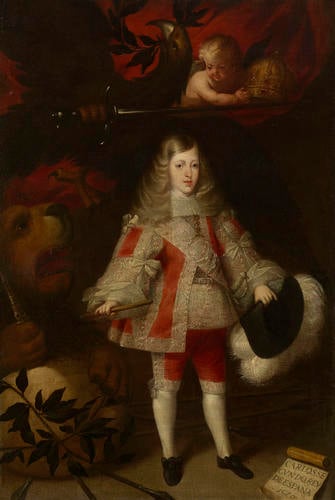-
1 of 253523 objects
Carlos II, King of Spain (1661-1700) Dated 1670
Oil on canvas | 161.3 x 109.0 cm (support, canvas/panel/stretcher external) | RCIN 403020

Sebastián Herrera Barnuevo (1619-71)
Carlos II, King of Spain (1661-1700) Dated 1670
-
Carlos II was the last of the Habsburg dynasty to rule Spain. Known as 'the Bewitched' he suffered from physical and intellectual disabilities cause by generations of inbreeding and was regarded as a weak and ineffectual ruler. At his death he left the Spanish throne to his grand-nephew, Philip of Anjou, causing fears over a Franco-Spanish alliance which ultimately led to the War of Spanish Succession.
Attributed to Spanish court painter Sebastián Herrera Barnuevo, this portrait shows the last Spanish Habsburg King, Carlos II aged about nine. There are a number of versions of this painting, that in the Royal Collection, along with those versions in the Museu del Prado, Madrid (inv. no. P008201) and The State Hermitage Museum, St Petersburg (inv. no. ГЭ-1461) are considered the prime examples.
Sebastián Herrera Barnuevo was a Spanish painter, sculptor and architect who is known to have worked for Philip IV of Spain and his second Queen, Marianna of Austria as early as 1649. In 1667, he was appointed court painter to the infant Carlos II and executed a number of portraits of the young King. An innovative painter, Herrera Barnuevo broke with the traditions of his predecessors, specifically Juan Bautista Martínez del Mazo, by introducing allegorical motifs into his portraits, specifically angels bearing crowns and animals including eagles and lions as symbols of royal authority.
Possibly owing to the King's youth, Herrera Barnuevo has filled this portrait with emblems emphasising his regal status and power. He wears a richly decorated velvet suit with the Order of the Golden Fleece and carries the Baton of Command as evidence of his elegance and valour. A single angel holding a crown is almost crowded out of the upper regions of the painting by an enormous eagle which holds a sprig of laurel in its beak and carries a sword. It is possible that Herrera Barnuevo introduced the eagle in its ancient role an emblem of power or victory. The eagle also appeared on the Spanish coat of arms during the reign of Carlos II. In the lower left corner of the painting is a large and slightly awkward lion, holding a sceptre atop a globe and on the floor around the young King are an olive branch and a number of scattered lances. The inclusion of the lion and sceptre may have a double significance. Firstly as attributes of royalty, temporal power and military prowess, and secondly as representative of Spain offering the olive branch of peace to her enemies. The lances may be symbolic of the laying down of weapons.
The scrole in the lower right corner of the painting identifies the sitter at Carlos II of Spain and gives the date of the portrait as 1670.Provenance
Purchased by Gruner on behalf of Queen Victoria at the sale of the collection of King Louis Philippe, Christie's, 7 May 1853 (Lot 116), £19.
-
Creator(s)
(nationality)Acquirer(s)
-
Medium and techniques
Oil on canvas
Measurements
161.3 x 109.0 cm (support, canvas/panel/stretcher external)
176.9 x 124.2 x 7.0 cm (frame, external)
Category
Object type(s)
Alternative title(s)
Charles II, King of Spain (1661-1700)